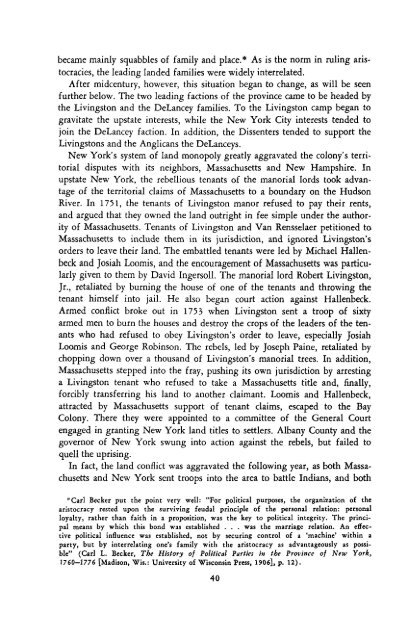Conceived in Liberty Volume 2 - Ludwig von Mises Institute
Conceived in Liberty Volume 2 - Ludwig von Mises Institute
Conceived in Liberty Volume 2 - Ludwig von Mises Institute
Create successful ePaper yourself
Turn your PDF publications into a flip-book with our unique Google optimized e-Paper software.
ecame ma<strong>in</strong>ly squabbles of family and place.* As is the norm <strong>in</strong> rul<strong>in</strong>g aristocracies,<br />
the lead<strong>in</strong>g landed families were widely <strong>in</strong>terrelated.<br />
After midcentury, however, this situation began to change, as will be seen<br />
further below. The two lead<strong>in</strong>g factions of the prov<strong>in</strong>ce came to be headed by<br />
the Liv<strong>in</strong>gston and the DeLancey families. To the Liv<strong>in</strong>gston camp began to<br />
gravitate the upstate <strong>in</strong>terests, while the New York City <strong>in</strong>terests tended to<br />
jo<strong>in</strong> the DeLancey faction. In addition, the Dissenters tended to support the<br />
Liv<strong>in</strong>gstons and the Anglicans the DeLanceys.<br />
New York's system of land monopoly greatly aggravated the colony's territorial<br />
disputes with its neighbors, Massachusetts and New Hampshire. In<br />
upstate New York, the rebellious tenants of the manorial lords took advantage<br />
of the territorial claims of Massachusetts to a boundary on the Hudson<br />
River. In 1751, the tenants of Liv<strong>in</strong>gston manor refused to pay their rents,<br />
and argued that they owned the land outright <strong>in</strong> fee simple under the authority<br />
of Massachusetts. Tenants of Liv<strong>in</strong>gston and Van Rensselaer petitioned to<br />
Massachusetts to <strong>in</strong>clude them <strong>in</strong> its jurisdiction, and ignored Liv<strong>in</strong>gston's<br />
orders to leave their land. The embattled tenants were led by Michael Hallenbeck<br />
and Josiah Loomis, and the encouragement of Massachusetts was particularly<br />
given to them by David Ingersoll. The manorial lord Robert Liv<strong>in</strong>gston,<br />
Jr., retaliated by burn<strong>in</strong>g the house of one of the tenants and throw<strong>in</strong>g the<br />
tenant himself <strong>in</strong>to jail. He also began court action aga<strong>in</strong>st Hallenbeck.<br />
Armed conflict broke out <strong>in</strong> 1753 when Liv<strong>in</strong>gston sent a troop of sixty<br />
armed men to burn the houses and destroy the crops of the leaders of the tenants<br />
who had refused to obey Liv<strong>in</strong>gston's order to leave, especially Josiah<br />
Loomis and George Rob<strong>in</strong>son. The rebels, led by Joseph Pa<strong>in</strong>e, retaliated by<br />
chopp<strong>in</strong>g down over a thousand of Liv<strong>in</strong>gston's manorial trees. In addition,<br />
Massachusetts stepped <strong>in</strong>to the fray, push<strong>in</strong>g its own jurisdiction by arrest<strong>in</strong>g<br />
a Liv<strong>in</strong>gston tenant who refused to take a Massachusetts title and, f<strong>in</strong>ally,<br />
forcibly transferr<strong>in</strong>g his land to another claimant. Loomis and Hallenbeck,<br />
attracted by Massachusetts support of tenant claims, escaped to the Bay<br />
Colony. There they were appo<strong>in</strong>ted to a committee of the General Court<br />
engaged <strong>in</strong> grant<strong>in</strong>g New York land titles to settlers. Albany County and the<br />
governor of New York swung <strong>in</strong>to action aga<strong>in</strong>st the rebels, but failed to<br />
quell the upris<strong>in</strong>g.<br />
In fact, the land conflict was aggravated the follow<strong>in</strong>g year, as both Massachusetts<br />
and New York sent troops <strong>in</strong>to the area to battle Indians, and both<br />
*Carl Becker put the po<strong>in</strong>t very well: "For political purposes, the organization of the<br />
aristocracy rested upon the surviv<strong>in</strong>g feudal pr<strong>in</strong>ciple of the personal relation: personal<br />
loyalty, rather than faith <strong>in</strong> a proposition, was the key to political <strong>in</strong>tegrity. The pr<strong>in</strong>cipal<br />
means by which this bond was established . . . was the marriage relation. An effective<br />
political <strong>in</strong>fluence was established, not by secur<strong>in</strong>g control of a 'mach<strong>in</strong>e* with<strong>in</strong> a<br />
party, but by <strong>in</strong>terrelat<strong>in</strong>g one's family with the aristocracy as advantageously as possible"<br />
(Carl L. Becker, The History of Political Parties <strong>in</strong> the Prov<strong>in</strong>ce of New York,<br />
1760-1776 [Madison, Wis.: University of Wiscons<strong>in</strong> Press, 1906], p. 12).<br />
40
















